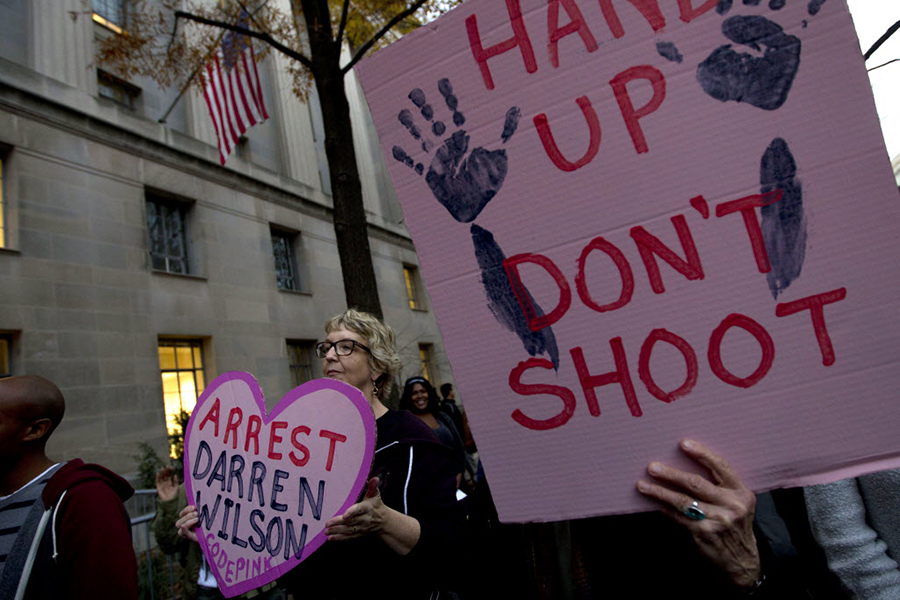Did Michael Brown really have his hands up when shot?
It is the image that has transfixed and divided a nation, been adopted as a symbol of police brutality by protestors, and become a rallying cry: "Hands Up, Don't Shoot."
But the St. Louis County grand jury did not indict Police Officer Darren Wilson in Ferguson, Mo., for fatally shooting Michael Brown on August. 9.
And for many Americans, the mystery remains: Was Michael Brown surrendering or charging the police officer at the time he was killed? Were his hands, as some witnesses have testified, indeed raised?
Though it has never been confirmed with visual evidence, that image – of Brown with his hands in the air - has gone viral as a symbol of injustice. Protesters across the country marching in the streets chanting, "Hands up. Don't shoot," and "I’ve got my hands on my head, please don’t shoot me dead.” Placards have circulated depicting two hands, palms out, as well as hands-raised T-shirts. There's a #handsupdontshoot Twitter hashtag.
This week both a group of lawmakers and athletes made headlines and stirred controversy for making raised hands gestures in protest of the grand jury decision: Five players for the St. Louis Rams made the gesture while coming onto the field before Sunday's game against the Oakland Raiders, and several lawmakers made the gesture on the House floor Monday evening.
Some have criticized that gesture, like MSNBC Morning Joe host Joe Scarborough, who has repeatedly called it "a lie."
"What is wrong with these people? What is wrong with these elected officials?" Scarborough asked on Tuesday morning's show. "They know it's a lie. They know the cops didn't shoot him with his hands in the air."
The question at the heart of the controversy has been extremely difficult to ascertain.
Witness testimonies provide clues, but they are wildly conflicting.
According to a PBS Newshour analysis of witness testimony, more than 50 percent of the witness statements said that Brown held his hands up when Wilson shot him, some 16 of 29 statements. Still, a solid 13 could not confirm that Brown made such a gesture.
And while many witnesses said they saw Brown's hands raised in some fashion, there was wide disagreement over what the gesture meant, as the Washington Post reported.
"One witness who thought Brown was charging said she saw his hands balled up into fists. Others thought the raised hands were a gesture of surrender, though some of these witnesses said they were not lifted in the traditional way, with the hands high and palms facing forward. Others thought Brown had touched a wound on his body and raised his hands in shock."
To illustrate the witnesses' varying interpretations of what they saw, the Post published a graphic, "Descriptions of Brown's Movement," that showed how differently observers perceived his actions. The same behavior by the same man was alternately described as both "charging" and "surrendering," as well as a host of other descriptors in-between.
One of the oft-cited witnesses, an employee of a maintenance company who was working at the apartment complex near the scene of the incident, testified that Brown first ran from the officer, then stumbled to a halt and spun around toward Wilson.
“Michael Brown was kind of moving at him like, ‘I’m giving up, hands up,’ ” the witness said. He said he heard Brown shout, “OK, OK, OK.”
Another oft-cited witness known as Witness 10 testified that after Brown turned to face Wilson, he went “full charge at the officer.” The witness said Brown “was not in a surrendering motion of ‘I’m surrendering, putting my hands up,’ or anything.”
Adding confusion - or clarity - to the mix are three separate autopsy reports that attempt to answer the question.
One, an autopsy performed by the county, showed that the sixth gunshot that struck Brown took a trajectory that did not suggest Brown had his hands in the air in a surrender position. The shot entered the forearm from the back and traveled into the inner arm from there, "inconsistent with Brown having his arms in the air, palms facing outward, in an attempt to surrender," reported the National Review.
As for the witness testimonies, "Some of the witness accounts of the shooting differed so much they didn't seem like the same scene," reported the AP.
"It's difficult for people under the best of circumstances to accurately report what happened," Elizabeth Brondolo, a psychology professor specializing in the effects of race on mental and physical health at St. John's University in New York, told the AP.
That's because witnesses' backgrounds and life experience color what they see.
"The truth always really matters, but it's important to recognize that past experience to stereotypes also influences the perception of hands being raised," Brondolo said.
Ultimately, however, for some, it doesn't matter whether Brown's hands were raised or not.
"Even if you don't find that it's true, it's a valid rallying cry," Ferguson protester Taylor Gruenloh told the AP. "It's just a metaphor."
A Seattle protester, Evan Chakroff, said the gesture is symbolic, not literal.
"My sense is that it's totally symbolic and a way of representing powerlessness" in the face of inequality and militarized police, he told the AP.
Others have gone so far as to say that focusing on the exact circumstances of Brown's shooting misses the point of the slogan.
"This is not about one boy getting shot in the street, but about the hundreds just like him who have received the same callous and racially influenced treatment," Oakland, California, protester Gabe Johnson, told the AP. "So ultimately, no, it doesn't matter at all if somehow we can say for sure whether this one young man really said these words or had his hands up."






